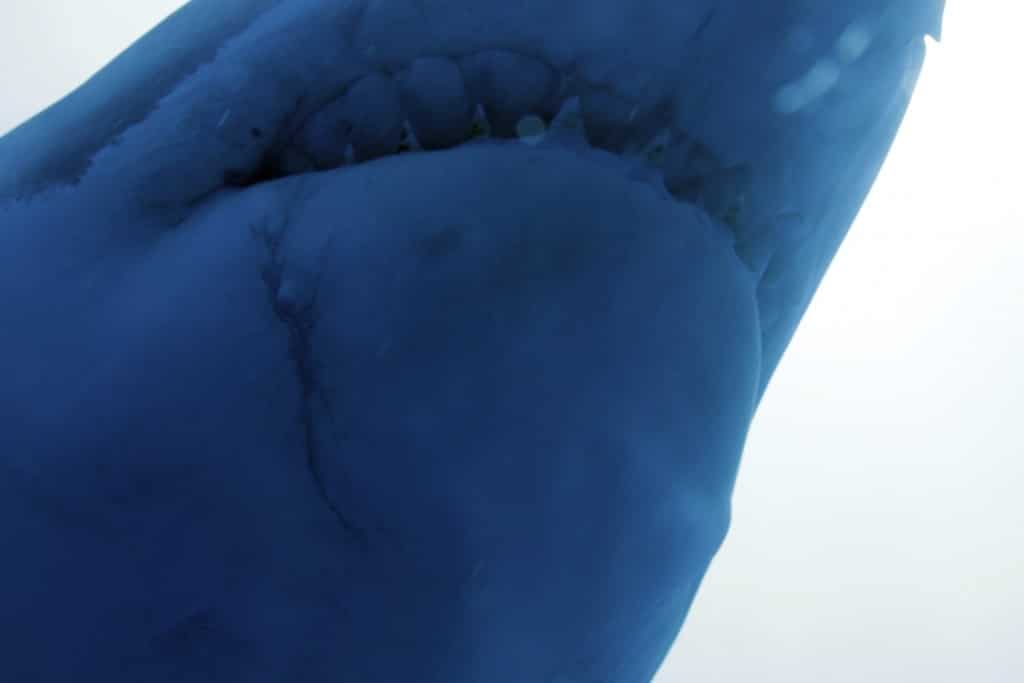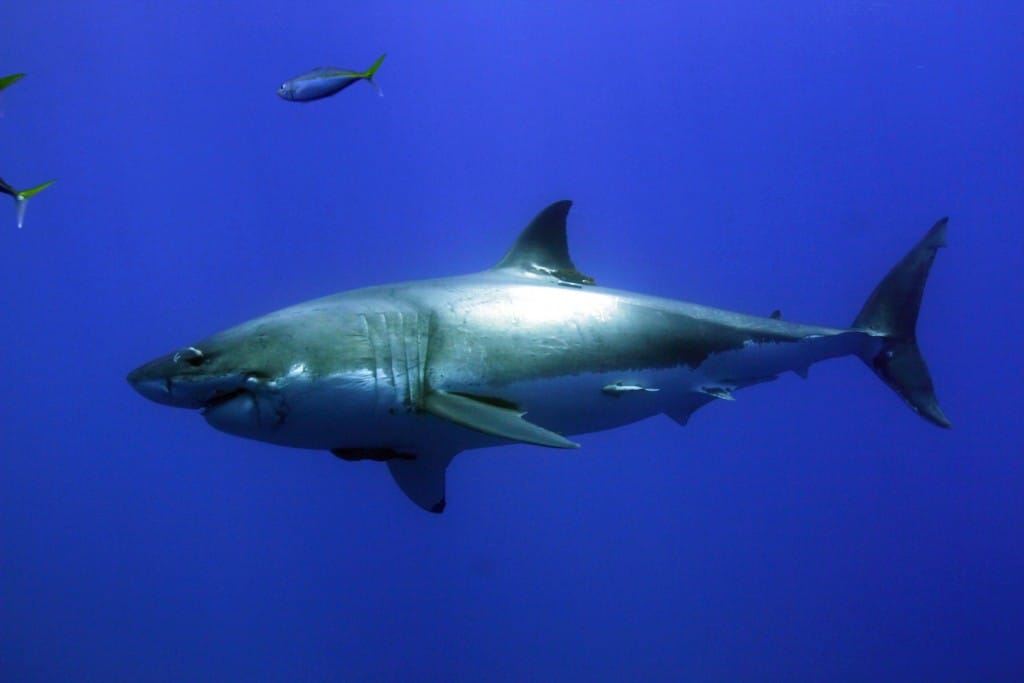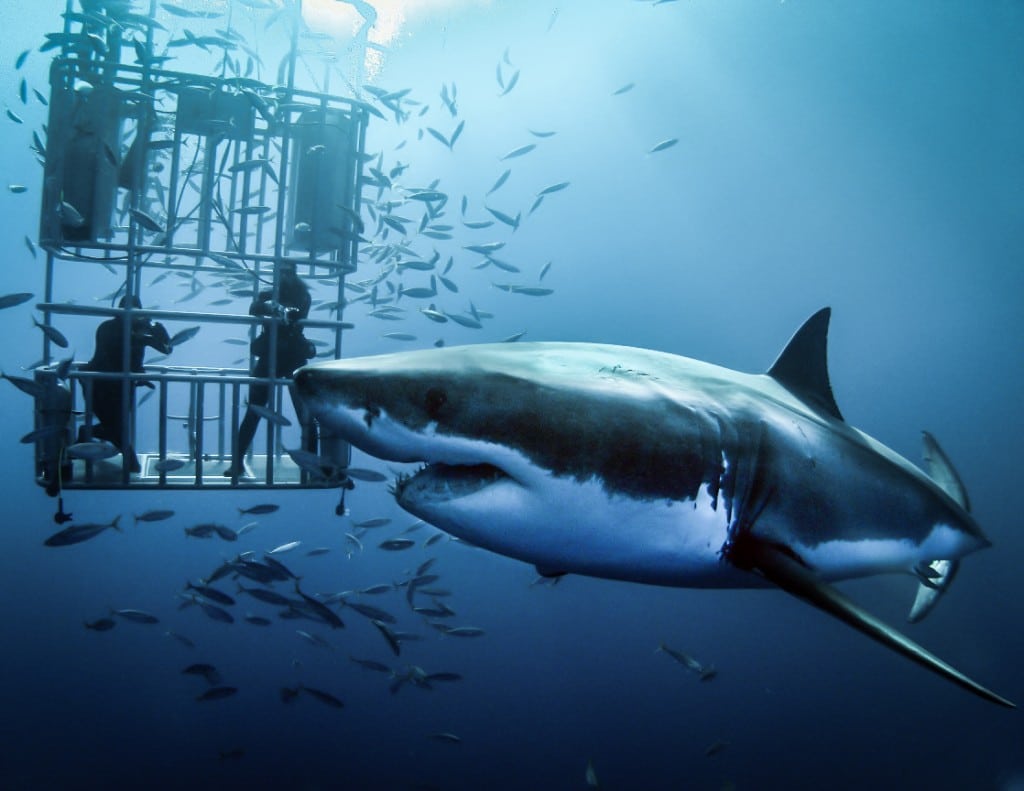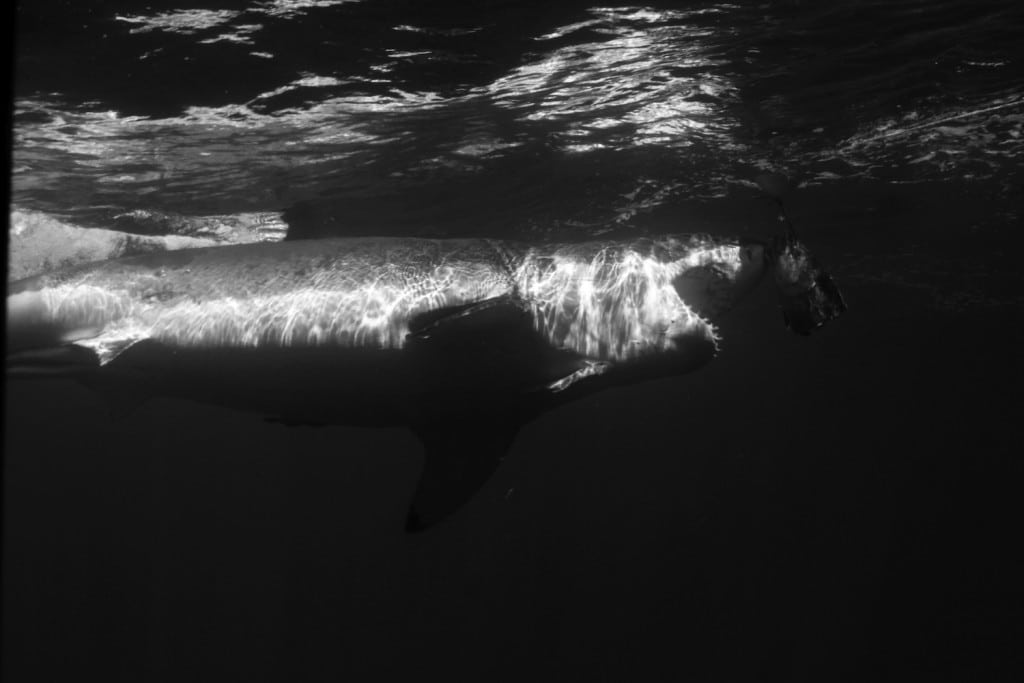Marine Life & Conservation
The Origin and Development of Cage Diving with White Sharks: Part 1

“Sharks are eating machines, and nobody’s told them not to eat us.” Rodney Fox
Last October it happened again: A video showed how a white shark broke through the bars of a shark cage in front of the Mexican island of Guadalupe. A horror for the diver – but also the shark itself. The animal rammed the metal construction and got into it. Helplessly, the crew watched as the shark panted and freaked out in the cage. They opened the lid of the cage in the hope that it would get out again. It took about 50 seconds until it was clear that the diver was not injured. The most battered was the shark himself, who, after panicking tried to get out of the cage. It was hurt and swam away bleeding.

If you are doing some internet research, you will find around half a dozen similar cases. Headlines such as “shark breaks through cage diving rods” or “divers in danger of life: white shark penetrates into cage” rule the gazette and tabloid papers. For years there has been a great controversy between animal protectionists and divers on the subject of cage diving. Some consider it to be irresponsible and demand an immediate stop of these excursions because the hunting instinct of the white sharks are triggered when fed with bait. They would become aggressive and lose their timidity against people.
Many suspect a connection with the increasing attacks on swimmers and surfers off the coast of South Africa. In 2009 and 2010 alone, 14 incidents were recorded, six people died. However, advocates of cage diving claim that sharks are not fed at all, but only attracted and lured to the boat with chum and believe that through this kind of encounter people recognize the white shark’s value as protective creatures.

A closer look at the history of cage diving…
It’s a strange thing with white sharks. While many scuba divers cannot get enough white sharks in front of their masks, most other people are happy when they never see one. The (wrong) picture of the beast lies too deep in our minds, about the killer with the jagged teeth. Something peculiarly sinister. It’s an eerie feeling to suddenly be part of the food chain when you enter the ocean. You could be human prey and end up in a monster’s stomach.
“What is a monster? To a mouse, a cat is a monster. We are just used to being the cat.” This classic line from the movie “Jurassic World” shows the myths of antiquity when thinking about big predators. Some divers are concerned less about their lives when it comes to white sharks, but rather about how they can at least see some of the elegant predators? The answer is – doing cage diving!

20 years ago, cage diving was reserved for daredevils and experienced divers. Nowadays, thanks to increased regulations and safety measures, almost anyone and even children can indulge this adrenaline “kick”. You do not even need scuba diving training. Eye to eye with a white shark – for many it is on their bucket list. That is why cage diving has now become a multi-million-dollar business. There are only four places in the world where you can pursue this thrill: the most famous are South Africa (False Bay and Gansbay) and South Australia (Neptune Islands near Port Lincoln). In California, you have the Farallon Islands and relatively new is the opportunity in New Zealand, at Stewart Island in the very south. The reason: in these places, there are large seal colonies, the main prey of the white sharks.
Australia – How it all began
No, for once it did not start with Richard Dreyfuss as Matt Hooper and his jump into the cage in “Jaws”. Cage diving started in the late 60s, around Dangerous Reef and other places in the South Australian Spencer Gulf. Experienced divers like Ron and Valerie Taylor, or Rodney Fox, made their first attempts at cage diving. They benefited from South Australian fishermen, such as Alf Dean, who had developed techniques to lure white sharks to their boats.
One of the most famous and widely discussed shark incidents of all time, is the attack on Rodney Fox: This attack took place on December 8, 1963, at Aldinga Beach, about 50 km south of Adelaide. This incident became so popular because Fox was the first person to survive a white shark attack and talk about it later. The doctors needed 462 stitches to sew him together and save his life. Fox then came up with an idea:
“My wife and I were at the zoo and we watched lions and tigers behind bars. The thought came to me: Perhaps one can also observe sharks from a cage. Around 1965 I organized an expedition with two other shark attack victims, to observe white sharks. The animals were more interested in the bait than in us. When I was in the water with those apex predators, I became aware that I no longer wanted to be an insurance agent. So, I quit my job, started to collect abalone mussels and offer white shark trips.”

Rodney made plans and then built the first two-man cage. He organized a new boat and found sponsors for the shark expedition. With guests, shark attack victims Brian Rodger and Henri Bource, Rodney called Ron Taylor to film the expedition in partnership with him. This was the first time that great white sharks were filmed under water. It was a turning point in the life of Rodney Fox. He discovered that white sharks were not crazy about human flesh, but fascinating and cautious creatures. Rodney, Ron and Valerie’s film “Blue Water, White Death” was a great success and was shown in 1971 in many countries around the world. During the shooting, large “gorilla cages” made of steel were used. This was safe, but also very time-consuming and therefore cost several thousand dollars.
“Then I received this incredible call from Hollywood to see if I could help the film crew with real shark footage for ‘Jaws’. At this time, we had no idea that this movie would give the shark such a bad image. The film crew visited me in Port Lincoln, where I lived. In addition, one of the screenplay authors came, Carl Gottlieb. They gave me their storybook and showed me what they needed. We filmed the white sharks in the next days from the right, from the left, from the top from below.”
In 1976, shortly after “Jaws” was published, Rodney received a request from an American dive company who wanted to bring their customers on a shark expedition. Rodney was happy, and it was the world’s first cage diving tour – the first of many, as it turned out. Thereupon the Taylors developed light-floating cages, which were more suitable for film purposes than the heavier ones used in commercial cage dive trips. The Taylors had found that heavy cages were unnecessary because sharks usually swam around the cages and did not even try to penetrate the cage. The result were light wire mesh cages with galvanized steel frames, side doors and deck flaps.

South Africa
In South Africa, cage diving is of younger origin and was only practiced sporadically in the western Cape Province around Struis Bay (east of Cape Agulhas) and in False Bay near Cape Town in the late 1980s. In 1997, seven commercial cage dive operators finally entered the Dyer Island Channel at Gansbay. Among them, hard and aggressive competition developed, which also disturbed research, seal and bird colonies. The events finally culminated in threats and trials between individual groups, as more and more funds for films and ecotourism flowed to Gansbay and led to a “cowboy mentality”. Ironically, scientific organizations have received less and less research funding for the white shark research at Dyer Island and elsewhere, while commercial cages and travel agencies have made a fortune with the increasing flood of people who wanted to see and film white sharks.
Personal experiences
The “Apex Predator”, “The Ultimate Killing Machine”, “The Perfect Hunter” – when talking about white sharks, superlatives are fast at hand. In every children’s card game it would be the trump card: the world’s biggest predator fish, the white shark. They are usually between four and five meters long and can reach a maximum of six meters and weigh more than two tons. I also wanted to see this animal “live”.

In 2001, I applied to the White Shark Research Institute in Gansbay/South Africa as a student field assistant and was accepted. For three weeks, I could work with the world-famous shark expert Craig Ferreira. Craig was one of the driving forces in a lobby that led to the protection of the white sharks in South Africa in 1991. It was hard to believe that his father Theo was once a notorious hunter who later became an environmentalist.
Even today, the story about Theo Ferreira and his hunt for a notorious shark, which they only called “the Submarine” is still being told. This white shark, was said to be as big as a submarine, supposedly seven meters in length and five tons in weight. Theo harpooned him three times, but he could escape again and again. Craig later transformed the adventurous hunt into a fictional story in his novel ‘The Shark’.
Of course, Craig also told me all about the biology, reproduction, and behaviors of the sharks themselves. The institute owned two boats, the “Elasmo I” with twelve meters in length and the “Elasmo II” with nine meters in length. Each boat had a cage. To my great surprise, these were not heavy steel cages, as I knew from the documentary “Blue Water, White Death,” but simple two-man cages made of wire mesh fence, reinforced only by steel struts.
Also, the brochure with the “Cage Emergency Procedures”, was not very encouraging to me if something went wrong. I was a little nervous when I read: “Broken Air Line”, “Drifting Cage”, “Shark Entangled and Air Line Cut”. I was ready to leave. But that was only in case of emergency, Craig said with a broad grin on his face. If I had once believed where sharks are found, you only had to hold your bleeding finger in the water and they will promptly tear off your arm, I was now taught something better…

Our boat was anchored in front of Seal Island, 5 Kilometers from shore. We dumped liters of chum into the water (mashed up sardines). The minutes went by but nothing happened – nothing at all! No sharks far and wide. It almost seemed to me that the seals were laughing at me with their staccato-like howling. “If a white shark was swimming here, we wouldn’t be in the water, fool” they seemed to tell me. The waves were unrelenting on our boat, I tried to keep my balance. Although the nausea was getting worse, I was pumped with adrenaline, my eyes continuously scanned the water surface for the infamous dorsal fin.
Craig fastened two huge tuna-heads on a rope and threw them into the water. “The bait leads the sharks to the boat and makes sure they stay here for a while. When a shark wants to catch the tuna bait, I pull it away and lure it ever closer to the boat so we can study it well. As if you were attracting a donkey with a carrot”, Craig said. “It’s about keeping the shark by the boat, not feeding them with the bait. Because they should not link boats and humans with prey”, the expert said.
And then, after an hour or so, they came: first one, then two, then three and four. White sharks circled our boat, I could hardly believe my luck! Gracefully their dorsal fins cut through the water surface, their torpedo-shaped bodies were simply enormous. These sharks were between three and four meters long, so just a good average for a white shark. But it is not the pure length, which takes one’s breath away, but above all it’s the girth. If you have never seen a shark in reality, let me tell you that sharks are not thin, slender fish, such as barracuda. Their bodies are massive and conical at the same time, their chest fins act like huge wings of a jet fighter!

The water was greenish and murky. Because of the bad visibility it was difficult for me to keep the individual animals apart. But after another hour, Craig told me that ten different sharks were swimming around our boat – ten! And the most fascinating thing was that they were not at all aggressive. Rather curiously and carefully they approached the bait, snapped here and there for a tuna and dived leisurely. I understood quite quickly – these sharks were no brainless killer machines from the cinema, but highly developed, perfectly adapted predators.
False Bay
In 2010, I repeated my trip to South Africa, but this time I visited shark researcher Chris Fallows in False Bay. His TV documentaries ‘Air Jaws’, about the breaching white sharks are world famous. With his boat “Apex Predator” we went to Seal Island. We anchored nearly 100 meters from the island, the seals howled on the rocks, the wind rushed around my ears – it was a hellish noise. But it was a beautiful day with sunshine and calm sea, numerous seals swimming around in the water.
I just pulled the neoprene suit up to get into the cage, as the water exploded not far from the boat: a white spray fountain exploded into the air. I finally witnessed a white shark catapulting itself out of the sea to catch a seal. He jumped in complete silence and brought the total destruction on impact – a natural force that manifested itself as strong and invisible as a storm! The seal had no chance.
On this trip, I could deepen my studies and I was surprised to find some news: Chris did not use a chum to lure the sharks. “We have found that the sharks are here anyway and we do not need blood to lure the animals to our boat. A few tuna-baits and our seal decoy are completely sufficient”, he told me.

During this trip, we had eleven white sharks around our boat, the largest measured roughly more than 4 meters. And the cages had changed a lot: now there were long steel cages with space for at least four to six people, which were attached to the boat. There were no diving bottles or air hoses – when a shark approached the cage, we just dived down with the air in our lungs for a few seconds. So, you did not need a divers licence – just a little courage.
Not only in Gansbay and False Bay there are large seal colonies, but also in Mossel Bay, some 400 kilometers further east. Here you can also find a large rock with a seal population of around 3,000 animals. While in the first two locations the islands are located about five kilometers from the mainland, the seals in Mossel Bay are only 800 meters from the beach – very close to swimmers and surfers! It could be assumed that there are many attacks on humans – but the opposite is the case. The only deadly attack took place in the vicinity on 29 August 2009 on surfer Gerhard van Zyl. His right lower leg was bitten off, he died a little later from the blood loss in hospital.
The seal colony is largely left alone by the sharks. As a reason, Fallows suspects that the white sharks in Mossel Bay are subadult animals up to a maximum of three meters in length. They hunt mainly fish and are not yet big enough to kill seals. Therefore, Mossel Bay is a kind of “training camp” for the sharks. Once they have learned to sneak and chase here, they swim further south to Gansbay and False Bay.
Christian’s story continues in Part 2 tomorrow… as he travels to Guadalupe, Mexico and asks whether the cage industry and ‘shark tourism’ have any benefit for sharks. Check back tomorrow!
All photos by Christian Kemper unless otherwise stated.
 You can purchase Christian’s book, ‘Strange Pool Friends – Mein Freund, der Hai’, here.
You can purchase Christian’s book, ‘Strange Pool Friends – Mein Freund, der Hai’, here.
Marine Life & Conservation
Shark Trust launches Oceanic 31 Shark Art Auction

 After a two-year tour of UK art galleries, community spaces and aquariums, the Shark Trust’s acclaimed Oceanic31 exhibition takes its final bow at the Royal Geographical Society later this month. And the unique collection of artwork, depicting 31 species of oceanic sharks and rays, donated by 31 artists, is now open for bids from art lovers and shark enthusiasts. The online auction, launched today, will close on the 7th December at 8pm (BST). The money raised will support the Shark Trust Oceanics Programme.
After a two-year tour of UK art galleries, community spaces and aquariums, the Shark Trust’s acclaimed Oceanic31 exhibition takes its final bow at the Royal Geographical Society later this month. And the unique collection of artwork, depicting 31 species of oceanic sharks and rays, donated by 31 artists, is now open for bids from art lovers and shark enthusiasts. The online auction, launched today, will close on the 7th December at 8pm (BST). The money raised will support the Shark Trust Oceanics Programme.
People can now bid on 27 of the artworks by visiting this website:
https://superstars-auctions.com/sharktrustauction
It is a chance to own a beautiful piece of original art and to support the Shark Trust. The timing of the auction also means that these would make a very special Christmas gift for any shark-lover.
- Bigeye Thresher Shark by Janina Rossiter
- Carcharodon carcharias by Jimmy Higgs
- Croc VR 2030 by Tom Mead
- Oceanic Whitetip by ATM
- Silky Street by ScapaJoe
The diversity of pieces mirrors that of the sharks and rays they represent. You can bid on paintings, digital creations, sculptures, mixed media and more. You can pick your favourite artist or species of shark. Or you can select the perfect artwork to make a statement in your home or office. Whichever you choose, you will be supporting the work to protect these amazing animals.
One of the pieces of art has been selected to be auctioned live by Steve Backshall at the For the Love of Sharks event at the Royal Geographical Society in London on the 29th November. In addition to this, two further pieces will be raffled at this event, giving people a chance to win an incredible piece of shark art. For the Love of Sharks is the Shark Trust’s flagship evening. A night to celebrate sharks. Steve Backshall is the headline speaker at this event that will see other prominent shark advocates join him on stage.
Tickets for the event can be snapped up here:
https://thesharktrust.org.uk/Event/flos24
Those that would like to see the Oceanic 31 exhibition have one final chance. It is being displayed at the Pavilion at the Royal Geographic Society from 26th November until the 7th December. Entry is free.
Find out more here:
https://www.rgs.org/events/upcoming-events/oceanic-31
Paul Cox, Shark Trust CEO, Said “This exhibition has given us the opportunity to reach out to a new audience. And inspire more people with the wonderful sharks and rays on which our Big Shark Pledge campaign is based. We are immensely grateful to the 31 artists who have worked so hard to create these works.”
Bid for your favourite Oceanic 31 artwork here:
https://superstars-auctions.com/sharktrustauction
Banner Image: Smooth Hammerhead by Alicia Hayden
Marine Life & Conservation
Meet Steve Backshall in the Bite-Back Prize Draw

Until 28 November, prizes worth a massive £10,000 – including experiences, products and tuition – feature in a line-up of items that can be won for £5 in an online prize draw to celebrate Bite-Back Shark & Marine Conservation’s 20th anniversary and help generate crucial funds for the future.
Top of the list of prizes is the chance to spend time with adventurer and wildlife expert Steve Backshall, a workout session with Nat Geo star Aldo Kane, a kayaking trip alongside white-water expert and diver Sal Montgomery and a Zoom call with ‘shark whisperer’ Cristina Zenato.
On top of that, some of the most admired companies in the diving and scuba industry have been quick to support the charity with fabulous prizes that make the £5 ticket price worth more than just a flutter.
Master Liveaboards, BSAC, Midlands Diving Chamber, Go Freediving and Blue Shark Snorkel have all generously donated experience prizes, while celebrated photographer Alex Mustard has donated a print and artists Scott Gleed and Olivier Leger have donated a sculpture and illustration to help boost the fundraising pot.
Fourth Element has donated Ocean Positive gear and LA watch company Nodus has gifted the charity a stunning dive watch. For land lovers, the charity has included a five star London hotel stay at Bankside Hotel plus a family visit to Longleat Safari Park in the roster of prizes.
Campaign director for Bite-Back, Graham Buckingham, said: “We’ve been overwhelmed with support from companies and individuals that we truly admire and who have supported us on our 20 year journey and we’re truly grateful to them all. While we feel incredibly proud of our achievements over the past two decades – and we are super excited about the next chapter – this prize draw isn’t a vanity project. It represents a real lifeline to our work and important advancements in the global protection of sharks. So we hope divers, dive clubs and even bargain hunters grab some tickets to make this a massive success.”
The charity hopes that the prize draw will generate crucial funds to launch a brand new, ground-breaking, campaign to enrol the public and increase support for the protection of sharks around the world.
To enter the competition visit www.bite-back.com/prizedraw. The prize winners will be announced on 1 December 2024.
-

 News1 month ago
News1 month agoIconic SS United States to become the World’s Largest Artificial Reef
-

 Blogs3 months ago
Blogs3 months agoNovoScuba’s Game-Changing Approach for Dive Store Owners: WE PAY YOU!
-

 News2 months ago
News2 months agoBook Review – 52 Assignments: Underwater Photography
-

 Gear News2 months ago
Gear News2 months agoDYNAMICNORD – New German diving brand enters the British market
-

 News2 months ago
News2 months agoExploring Cenote El Pit: A Diver’s Dream
-

 Gear News2 months ago
Gear News2 months agoTry BARE drysuits (and maybe even win one!) this Friday with Sea & Sea at North West Dive Fest
-

 News3 months ago
News3 months agoComing Soon – 52 Assignments
-

 News3 months ago
News3 months agoSave £200 per person per week at Pole Pole Lodge with Dive Worldwide








